Fourteen women have steered Wellesley’s course over 140 years.
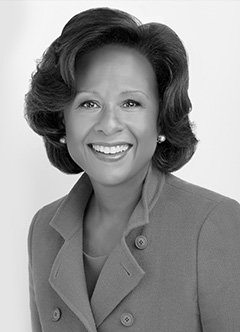 Paula A. Johnson, inaugurated 2016
Paula A. Johnson, inaugurated 2016
Paula A. Johnson is the fourteenth president of Wellesley. Since taking office in July 2016, she has emphasized the College's mission in educating women to make a difference in the world by imagining new opportunities, challenging assumptions, and celebrating difference. Under her leadership, the College is focused on strengthening the transition between a liberal arts education and a meaningful life and career after college by building a new career education center; developing a new model for residential life on campus that emphasizes wellness and community; and leading the most ambitious fundraising campaign in Wellesley’s history.
As a cardiologist, researcher, and expert in public health and health policy, Johnson has devoted her career to transforming the health and well-being of women. Before coming to Wellesley, she was the founding executive director of the Connors Center for Women’s Health and Gender Biology, chief of the Division of Women’s Health at Brigham and Women’s Hospital, professor of medicine at Harvard Medical School, and professor of epidemiology at the Harvard T.H. Chan School of Public Health. Her research efforts have focused on discovering how disease is expressed differently in women and men, influencing health policy, and studying leadership to advance the health of women globally. Johnson attended Harvard and Radcliffe Colleges, received her MD and MPH degrees from Harvard, and trained in internal medicine and cardiovascular medicine at Brigham and Women’s Hospital.
 H. Kim Bottomly, 2007-2016
H. Kim Bottomly, 2007-2016
H. Kim Bottomly received an undergraduate degree in zoology and a doctorate in biological structure from the University of Washington, after which she did postdoctoral work in immunology at the National Institutes of Health. She spent 27 years on the faculty of Yale University, her laboratory focusing on the molecular and cellular factors that influence the initiation of immune responses. She also served as Yale’s deputy provost for science, technology, and faculty development.
The first scientist to lead Wellesley, Bottomly successfully shepherded the College through the recession of 2008, establishing a lasting model for financial sustainability in the process. Under her leadership, Wellesley launched the Madeleine Korbel Albright Institute for Global Affairs, developed a new college to career program for students and alumnae, partnered with Babson and Olin to create the Three College Collaboration, and initiated a major renewal program to preserve Wellesley's beautiful campus. She also established Wellesley as the first liberal arts college to join edX, the Harvard-MIT online learning collaborative; formed the President’s Commission on Ethnicity, Race, and Equity; and led the effort to reaffirm Wellesley as a women’s college for the 21st century. Since leaving Wellesley, Bottomly has continued to be a strong proponent of advancing women in the sciences. She is a fellow of the National Academy of Arts and Sciences, a fellow of the National Academy of Inventors, and a member of the Leadership Council of the Yale School of Engineering. She was named a member of the University of Washington’s “Wondrous One Hundred,” the top alumni of the past 100 years.
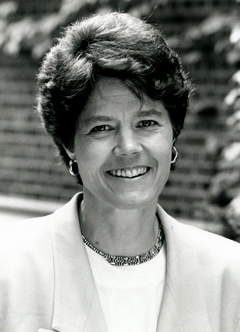 Diana Chapman Walsh '66, 1993-2007
Diana Chapman Walsh '66, 1993-2007
Diana Chapman Walsh was the 12th president of Wellesley and the fourth alumna to head the college. An English major at Wellesley, she went on to earn a master’s degree in Journalism and a Ph.D. in health policy from Boston University, where she subsequently served on the faculty. Named a Kellogg National Fellow in 1987, Walsh traveled throughout the United States and abroad studying workplace democracy and principles of leadership, as well as writing poetry. Immediately before returning to Wellesley in 1993, she was the Florence Sprague Norman and Laura Smart Norman Professor at the Harvard School of Public Health, where she chaired the Department of Health and Social Behavior.
During her tenure, the College undertook a number of new initiatives, including an expanded program in global education, experiential and service learning, and technology-assisted teaching and learning. Other important innovations during this period included the opening of the Davis Museum and Cultural Center, the establishment of the Religious and Spiritual Life Program, and the construction of the Knapp Media and Technology Center. Since leaving Wellesley, Walsh has regularly written and consulted on a wide range of issues in higher education. She has also served as a director of several educational and philanthropic institutions, including the Massachusetts Institute of Technology and the Henry J. Kaiser Family Foundation.
 Nannerl Overholser Keohane '61, 1981-1993
Nannerl Overholser Keohane '61, 1981-1993
Nannerl Overholser Keohane '61 participated in the Washington Internship Program while a student. She attended Oxford University on a Marshall Scholarship before getting her Ph.D. at Yale. She taught political science at Swarthmore, the University of Pennsylvania, and Stanford before returning to Wellesley College as its 11th President.
Under her leadership, Wellesley embraced multiculturalism. The College's sports facilities were vastly improved during her tenure and the Davis Museum and Cultural Center were built. The first-year cluster program and the writing and multicultural requirements were instituted. Advances in technology included automation of the library's catalog, the beginning of the College web site, and the installation of the satellite dish. Keohane left Wellesley in 1993 to become the first woman president of Duke University.
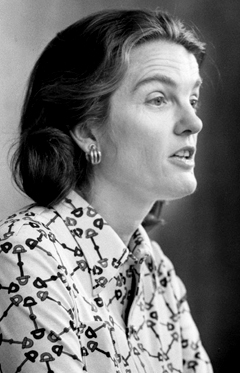 Barbara W. Newell, 1972-1980
Barbara W. Newell, 1972-1980
Barbara Newell, an economist, was educated at Vassar and the University of Wisconsin. Before coming to Wellesley College, Newell taught and served as assistant to the president at the University of Michigan and as associate provost at the University of Pittsburgh.
During her term, Wellesley celebrated its centennial, and Newell served as an advocate for women's education and The Center for Research on Women opened. Science facilities were expanded and brought together in one place with the construction of the Science Center. From 1979 to 1981 Newell was the first woman to serve as U.S. Ambassador to the United Nations Education, Scientific, and Cultural Organization (UNESCO). After leaving Wellesley College, Newell served as the chancellor of the State University System of Florida (1981-85) and taught economics. In 1996, she married Ernest Kolowrat.
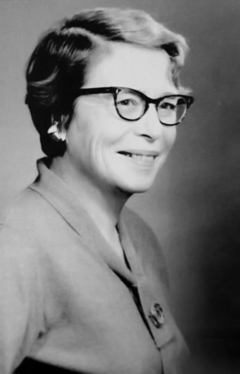 Ruth Adams, 1966-1972
Ruth Adams, 1966-1972
Ruth Adams was president of Wellesley during a turbulent period in American history. An alumna of Adelphi College with a master's from Columbia and Ph.D. from Radcliffe, Adams taught Victorian literature at the University of Rochester, and served as dean of Douglass College before coming to Wellesley.
During her administration, student participation in the governance of the College increased and students were permitted to serve on Trustee and Academic Council committees. Educational opportunities were broadened: A cross-registration program was established with MIT and exchange programs were established with 11 other New England liberal arts institutions. Wellesley decided to remain a single-sex institution. After leaving Wellesley, Adams became the first woman vice president at Dartmouth College where they had just decided to admit women students.
 Margaret Clapp '30, 1949-1966
Margaret Clapp '30, 1949-1966
Wellesley's second alumna president, Margaret Clapp '30 received a master's and Ph.D. in history from Columbia University. Clapp taught history at the New Jersey College for Women, Columbia, and Brooklyn College before returning to Wellesley. She won a Pulitzer Prize for her biography, Forgotten First Citizen: John Bigelow.
During her term a number of changes were made to the campus: Bates, Freeman, McAfee, faculty housing, the Jewett Arts Center, and a major addition to the Library were built. The amount available for financial aid to students was increased. After leaving Wellesley, Clapp served as principal of Lady Doak College in Madurai, India, and as U.S. cultural attaché to the U.S. Embassy and head of the U.S. Information Agency's cultural operations in India. She died in 1974.
 Mildred McAfee Horton, 1936-1949
Mildred McAfee Horton, 1936-1949
Mildred McAfee, a Vassar alumna, received her master's degree from the University of Chicago. Before coming to Wellesley College, she taught economics and sociology, and was dean of women at Centre and Oberlin Colleges. McAfee was given a leave of absence during World War II to become the first director of the WAVES (the women's branch of the Navy). For nearly three years she divided her time between Wellesley and Washington. In 1945, She was awarded the Distinguished Service Medal.
After leaving Wellesley, she served on a number of corporate, civic, and educational boards. She was vice president of the Federal Council of Churches, the National Council of Churches, and President of the American Board of Commissioners for Foreign Missions.
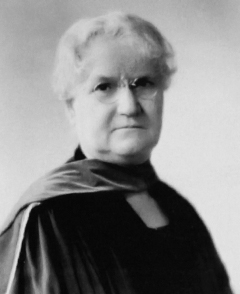 Ellen Fitz Pendleton 1886, 1911-1936
Ellen Fitz Pendleton 1886, 1911-1936
Wellesley's first alumna president, Ellen Pendleton '86, received both a B.A. and master's from Wellesley. She served as a member of the Mathematics Department and as dean before becoming president. Pendleton has the distinction of having the longest term as Wellesley College President—25 years! She brought the College through the College Hall fire in 1914, and the rebuilding of the dormitory, classroom, and office facilities lost in that disaster. Under her administration, there was a liberalization of the admission requirement and the curriculum. A program of honors in the major was begun. Under her stewardship, the College survived the Depression without cuts in staff or salaries.
 Caroline Hazard, 1899-1910
Caroline Hazard, 1899-1910
Caroline Hazard was the first Wellesley president to have a formal inauguration. Hazard, who held no formal college degree, was responsible for putting the College back on a sound financial footing. Hazard hired the noted landscape architect, Frederick Law Olmsted, Jr., to help develop the Wellesley College grounds. Under Hazards' aegis, and sometimes with her personal financial support, a number of buildings were constructed: the Observatory and Observatory House, the dormitories of the Hazard Quadrangle, and the Library. They carry her symbol, the scallop shell. She retired in 1910, but continued as a Wellesley College trustee until 1927. She died in 1945.
 Julia Irvine, 1894-1899
Julia Irvine, 1894-1899
Julia Irvine, a Cornell graduate and a professor of Greek at Wellesley, continued to teach after her marriage to Charles J. Irvine. Her tenure as president at Wellesley was marked by great changes in the faculty. Many of the early teachers who did not have formal training or college degrees were replaced with faculty who did have these credentials. Some of the rules for students such as mandatory Chapel attendance, domestic work, silent time, and the prohibition on Sunday library hours—rules which had a "seminary" air—were eliminated. After leaving Wellesley, Irvine lived in France. She returned to Wellesley College in 1913-1914 to reorganize and teach in the French Department.
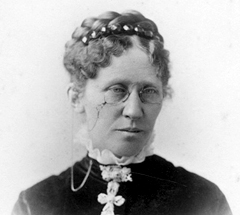 Helen Shafer, 1887-1894
Helen Shafer, 1887-1894
Helen Shafer, an Oberlin graduate, began her career at Wellesley as professor of mathematics. The chief achievement of her presidency was a major change in the College's curriculum which allowed more student electives. During her tenure, Wellesley established a psychological laboratory. Shafer died suddenly in January 1894, the only Wellesley president to die while in office.
 Alice Freeman Palmer, 1881-1887
Alice Freeman Palmer, 1881-1887
Alice Freeman was named acting president in 1881 at the age of 26. In the following year, she became president, Wellesley's youngest. Among the first women to graduate from the University of Michigan, Freeman was teaching history at Wellesley when Henry Fowle Durant died and Ada Howard left. During her years as president, faculty collegiality and responsibility were fostered. Academic Council was founded. As perhaps the most visible woman educator in the United States, she played a major role in defining a community of educated women. Her presidency ended in December 1887, a few days after she married George Herbert Palmer, professor of philosophy at Harvard. She continued to serve Wellesley as a member of the Board of Trustees. From 1892 to 1894 she served as dean of women at the University of Chicago, which had just begun to admit women.
 Ada Howard, 1875-1881
Ada Howard, 1875-1881
Ada Howard was a graduate of Mount Holyoke College. Howard had taught at Western College in Ohio, been the principal of the Woman's Department of Knox College in Illinois, and operated Ivy Hall, a school for girls in Bridgeton, New Jersey. Although she had the title of president, many of the decisions concerning the College were made by the College's founder, Henry Fowle Durant. Howard left Wellesley for health reasons shortly after the death of Mr. Durant in 1881. She lived quietly in New York City until her death in 1907.
Information and images courtesy of Wellesley College Archives; text courtesy of Wellesley College Institutional Research
